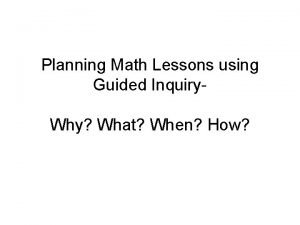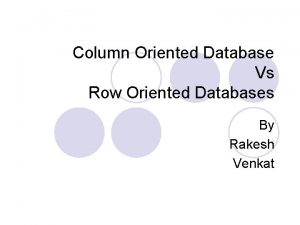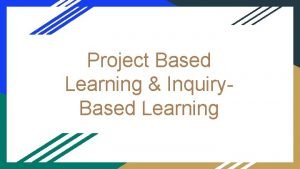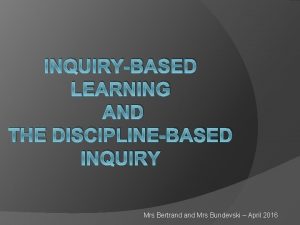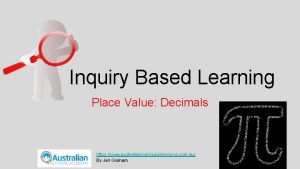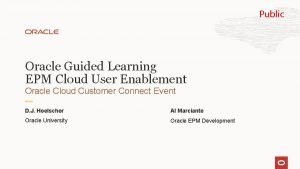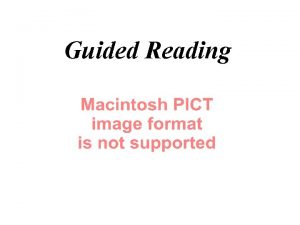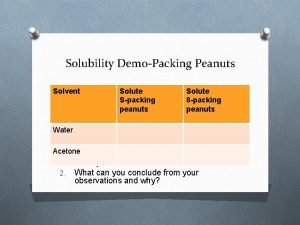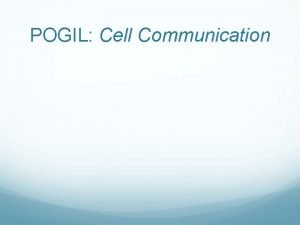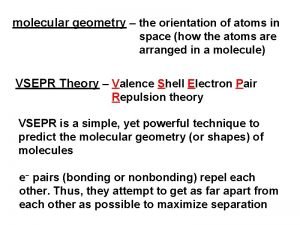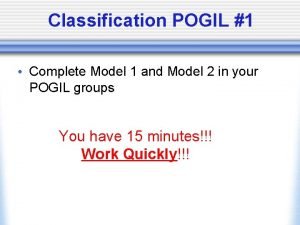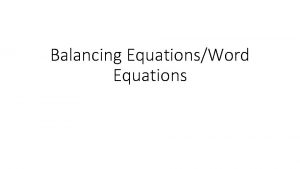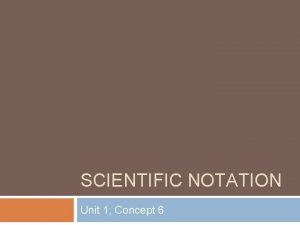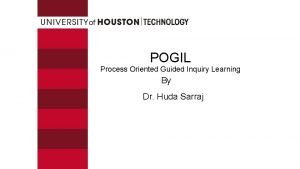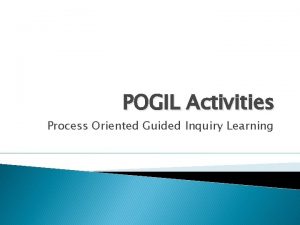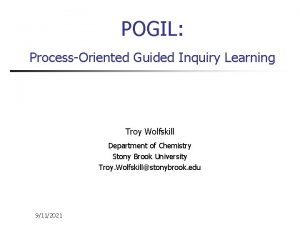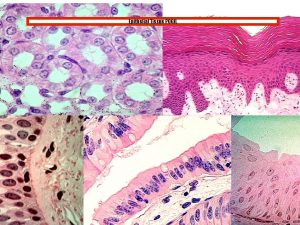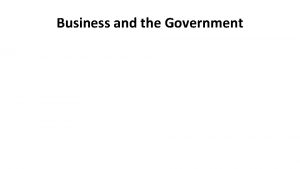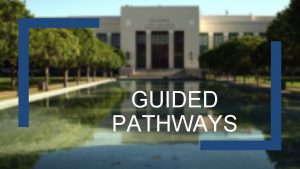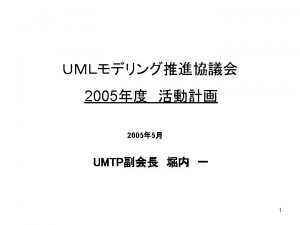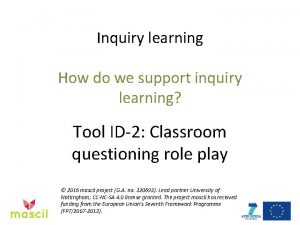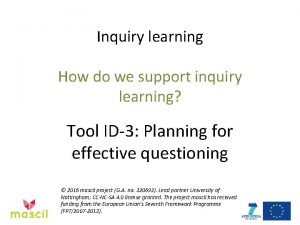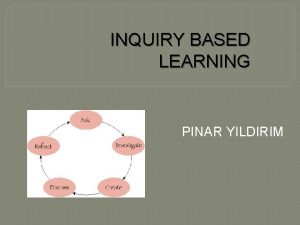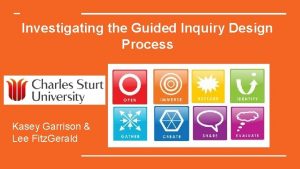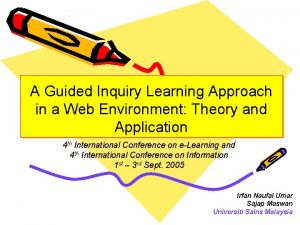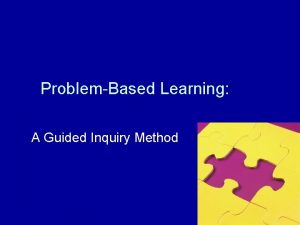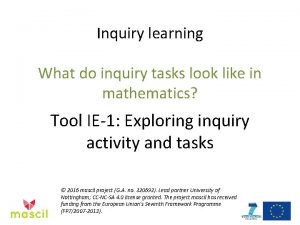PROCESS ORIENTED GUIDED INQUIRY LEARNING POGIL For the























- Slides: 23

PROCESS ORIENTED GUIDED INQUIRY LEARNING (POGIL) For the Math and Science Classroom Mary C. Roslonowski, Ph. D, Associate Provost, Palm Bay Campus

WORKSHOP OUTLINE • What is POGIL? • Why use POGIL? • How is the POGIL classroom arranged? • Team Activity Scenario • How do you assess POGIL? • POGIL Effectiveness • POGIL Disciplines • POGIL Resources • POGIL Material Development

POGIL DISCIPLINES • • • Analytical Chemistry Anatomy and Physiology Biochemistry Calculus Computer Science Engineering Math – Pre-Calculus, College Algebra, Calculus Physical Chemistry Preparatory Chemistry

WHAT IS POGIL? • POGIL is a classroom and laboratory technique that seeks to simultaneously teach content and key process skills such as the ability to think analytically and work effectively as part of a collaborative team. • POGIL classrooms or labs consist of any number of students working in small groups on specially designed guided inquiry materials. • POGIL materials supply students with data or information followed by leading questions designed to guide them toward formulation of their own valid conclusions. • POGIL instructors serve as facilitators, observing and periodically addressing individual and classroom-wide needs.

WHY USE POGIL? • Research indicates that teaching by telling does not work for most students. • Research indicates that students who are part of an interactive community are more likely to be successful. • Research shows that knowledge is personal; students enjoy themselves more and develop greater ownership over the material when they are given an opportunity. • POGIL practitioners find that discovery-based team environments energize students and provide instructors with instant and constant feedback about what their students understand misunderstand. • POGIL students quickly understand that logical thinking and teamwork are prized above simply getting the correct answer.

LEARNING CYCLE • E -------- I --------- A • Exploration, Concept Invention (Term Introduction), Application • Parallels the scientific method • Ideas do not appear in your brain fully formed • Being wrong is a stage on the way to being more right Karplus and Thier, A New Look at Elementary School Sciences, Chicago: Rand Mc. Nally (1967). Piaget, J. J. Res. Sci. Teach. 1964, 2, 176.

POGIL CLASSROOM • Class is divided into teams – 3 -4 students per team. • Each team member is designated with a role either Captain, Spokesperson, Recorder, and Reflector. Roles change either daily, weekly, or monthly. • Students work on specially designed POGIL materials – three parts to each module: Model, CTQ, Exercises and Problems. • POGIL materials guide students through an exploration to construct understanding. • POGIL materials use discipline content to facilitate the development of higher-level thinking shills and the ability to learn and apply knowledge in new contexts.

POGIL CLASSROOM MANAGEMENT • Facilitator is timekeeper and give students time limits. • Facilitator must communicate buy-in for the methodology. • Facilitator guides the students, doesn’t tell them the answer. • Facilitator allows captains to manage the teams and only intervenes when absolutely necessary. • Facilitator gives short, in-time, mini-lectures when something more is needed. • Facilitator tests the same way he/she would for a lecture course. • Facilitator places some point values on the in-cass activities.

TEAM ROLES - CAPTAIN • Keeps the process enjoyable and rewarding for all team members • Makes sure each team member has a role and is performing within that role • Ensures that all team members can articulate and apply what has been learned • Manages stress, time, and conflict • Facilitates the team process and its pacing; keeps members focused • Contributes to the group as an active learner • Accepts accountability for overall performance of the team

TEAM ROLES-SPOKESPERSON • Speaks for the team when called upon to do so • Asks questions posed by the team or requests clarification • Makes oral presentations to the class for the team • Uses the Recorder’s Report to share the team’s discoveries and insights • Collaborates periodically with the recorder • Contributes to the group as an active listener

TEAM ROLES-RECORDER • Records group roles and instructions as the beginning of the task or activity • Records and collects important information and data during an activity • Accepts accountability for the overall quality of the Team Activity Worksheet • Controls information flow, articulates concepts in alternative forms, if necessary • Prepares a report that can be used for discussion purposes; integrates and synthesizes when several ideas are presented • Contributes to the group as an active listener

TEAM ROLES-REFLECTOR • Assesses performance, interactions, and dynamics among team members • Listens and observes well • Analyzes and records strengths, improvements and insights of the team • Presents an oral Reflector’s Report positively and constructively if asked to do so • Intervenes with suggestions and strategies to improve the team’s processes • Contributes to the group as an active listener • Calculates answers to mathematical equations

POGIL CLASSROOM DEMONSTRATION “The Nuclear Atom” Chem. Activity Calculus Activity

ASSESSING POGIL • Exam Performance • Student Journal Reflections • Student Opinion Surveys • Standardized Exams • Soft Skill Assessments

POGIL EFFECTIVENESS • Research shows the methodology is at least as effective as lecture style. • Personally, one course, more effective in CHM 1045 (General Chemistry 1) based on exam grades. • Student feedback and engagement is very good. • Students aren’t afraid to express confusion, they ask questions frequently. • Classes fill. • Personally, I enjoy teaching the course so much more than lecture based.

EXAM GRADE COMPARISON • For CHM 1045, • POGIL group was significantly better in terms of test average, P value = 1. 17 x 10 -8 • Note large sample size (Traditional N = 218 and POGIL N = 117) • Result suggests including POGIL has increased student learning. • For CHM 1046, • No statistically significant difference among groups. • P value greater than 0. 05. • Result suggests that test score averages may not be different. • For CHM 2210, • No statistically significant difference among the groups. • Result suggest test score averages may not be different (the same or better). • Surprising result as students in this course were most receptive to the POGIL format. • For CHM 2211, • • 50/50 group was significantly better in terms of test average. P-value < 0. 001 POGIL and 50/50 showed better test average than Traditional Result suggests incorporation of POGIL has increased student learning.

POGIL RESOURCES • www. pogil. org - Resources • Numerous resources for biology, business administration, chemistry, education resources, math, and student centered learning

CREATING POGIL MATERIALS • “Model” can be text, equation, diagram, table, graph, figure, etc. • One to three key concepts developed • Key questions (could also be actions such as filling in a table, manipulating physical objects, etc. ) that clearly guide to desired concepts. • Application can be either within the set of critical thinking/key questions or exercises/problems, or both. • Optimally, specific process skill development takes place in the context of the activity (constructing or interpreting graphs, written communication, etc. )

“CONCEPT INVENTION ACTIVITY” • Follows learning cycle: Exploration – Term Introduction/Concept Invention – Application • The concept or concept to be developed are not explicitly presented in the Model. • Effective guidance can be a prediction based on current understanding followed by presentation of additional (often unexpected) information. • Terms (or general statements of conclusions developed) are introduced at this point – not at the beginning.

“CONCEPT FORMATION ACTIVITY” • The concept or concepts to be understood are explicitly presented in the “Model” at (or near) the beginning of the activity. • Provides an exploration/application of presented information: Term Introduction/Concept Invention-Exploration-Application. • Key questions reinforce understanding of presented concepts and develop process skills (e. g. careful reading, developing meaning/application of an equation or relationship, derivation of results, etc. )

BREAKOUT SESSION POGIL ACTIVITY DESIGN Teams 30 minutes

POGIL ACTIVITY REPORT OUT • Team Spokesperson reports on the designed activity: • • • Title Why? – focus question Prerequisites-prior knowledge and skills Learning Objectives Exploration Key Questions Skill Exercise: examples Problems Closure

THANK YOU FOR YOUR PARTICIPATION AND ATTENDANCE! Questions?
 Guided inquiry lesson plan
Guided inquiry lesson plan Scoring rubrics about design a museum exhibit
Scoring rubrics about design a museum exhibit Product principle in portfolio assessment
Product principle in portfolio assessment Sales promotion vehicles
Sales promotion vehicles Row oriented database
Row oriented database Cuadro comparativo de e-learning b-learning y m-learning
Cuadro comparativo de e-learning b-learning y m-learning Pros and cons of inquiry based learning
Pros and cons of inquiry based learning Ngss inquiry based learning
Ngss inquiry based learning Examples of inquiry based learning
Examples of inquiry based learning Inquiry-based learning strategies
Inquiry-based learning strategies Inquiry based learning definition
Inquiry based learning definition Advantages of problem-based learning
Advantages of problem-based learning Oracle epm training
Oracle epm training Guided reading objectives
Guided reading objectives Forms of dna
Forms of dna Quizlet
Quizlet Cell communication pogil
Cell communication pogil Polar molecule examples
Polar molecule examples Biological classification pogil
Biological classification pogil Balancing chemical equations pogil
Balancing chemical equations pogil Spectroscopy ap chem
Spectroscopy ap chem Significant digits and measurement pogil
Significant digits and measurement pogil Introduction to epithelial tissue pogil answer key
Introduction to epithelial tissue pogil answer key Isotopes pogil
Isotopes pogil
